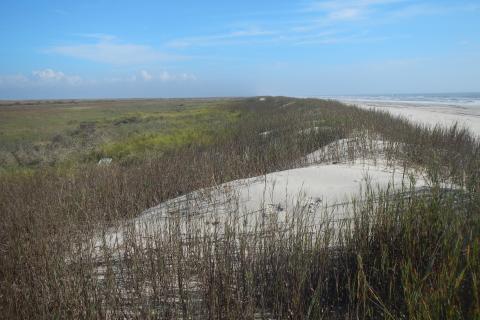In December 2021, construction began on the Texas Trustee Implementation Group’s McFaddin Beach and Dune Restoration Project, which includes restoring approximately 17 miles of eroded shoreline along the southern edge of McFaddin National Wildlife Refuge. In order to continue making progress on the project, the Texas Trustees increased the budget originally approved in their 2017 Final Restoration Plan by approximately $2.5 million.
McFaddin Project Background
The project will restore a beach and dune ridge barrier system that provides habitat for birds, and other beach and dune-dependent species.
The new beach and dunes will also act as a restored barrier protecting interior wetlands and coastal habitats of the Salt Bayou watershed and the fish, invertebrates, and other life that use them. The interior Salt Bayou ecosystem has an array of different habitat types including:
- Freshwater and saltwater marshes
- Coastal grassland prairies
- Submerged aquatic vegetation
- Tidal creeks
- Small bays
This diverse array of habitats creates an extremely productive area for fish and wildlife. They also provide outdoor recreational opportunities, and are the first line of defense for coastal communities from tropical storm events. The Salt Bayou ecosystem is the largest continuous estuarine marsh complex in Texas.
The Trustees’ contractor is using methods that have proved highly successful in the past. The restoration project is modeled after a 2017 pilot project, which restored 2.9 miles of shoreline in the same area. Sediment will be pumped to the beach from an area off the refuge’s coast. The sediment will then be graded to make new beach and dunes. Once that work is completed, the contractor will plant native plants in the restored dune system.
Decades of Work, in Its Final Phases
For decades, a group of state, local, and federal stakeholders worked to restore the Salt Bayou Watershed. In 2013, they completed the Salt Bayou Watershed Restoration Plan (PDF, 40 pages). Since that time, they’ve implemented four distinct restoration elements:
- Restoration of the mouth of Keith Lake Fish Pass
- Restoration of the Salt Bayou Watershed across the Gulf Intracoastal Waterway
- Restoration of the marsh inside the conservation lands
- Restoration of the beach ridge
The McFaddin Beach and Dune Ridge Project is the final piece of the watershed restoration plan.
Trustees Approve Budget Increase
The project was approved in the Texas Trustee Implementation Group’s Final 2017 Restoration Plan with an authorized budget of $15.8 million to contribute to the broader project supported by other programs and funds listed below. After the 2017 approval, the Trustees increased the authorized budget by $2.5 million, to a total of $18.3 million, due to price changes in the construction market since the project’s inception and additional technical modifications.
The Trustee Implementation Group’s analysis (PDF, 12 pages) includes more details about how the project’s changes do not affect its compliance with applicable policies and regulations.
Leveraging Funds With Our Partners
The estimated cost of the total project is $87 million. The Texas Trustee Implementation Group is partnering with other agencies and programs, and leveraging other funding sources to support the project including:
- Texas General Land Office’s Coastal Erosion Prevention and Response Act, and Surface Damage programs
- Jefferson County, Texas
- U.S. Fish and Wildlife Service
- National Fish and Wildlife Foundation's Gulf Environmental Benefit Fund
- The RESTORE Act and Gulf Coast Ecosystem Restoration Council
- Gulf of Mexico Energy Security Act


